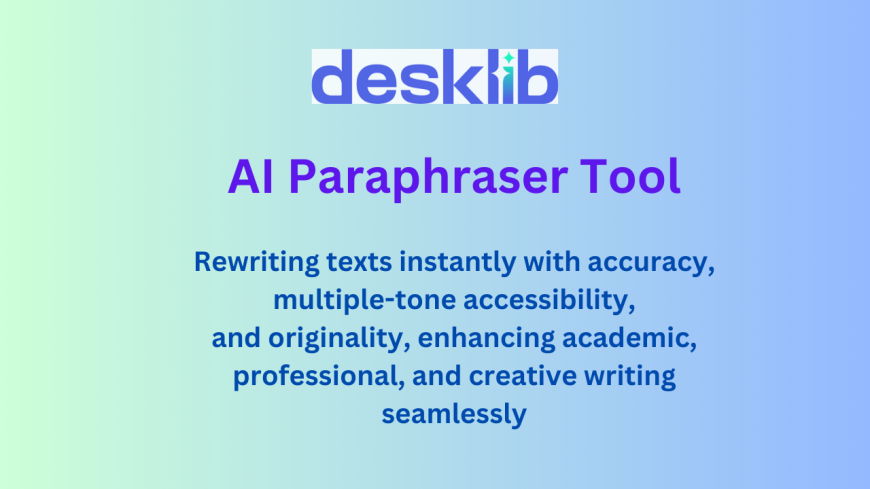AI Content Detector Tool: Evaluating Its Role in Academic Integrity
Explore the role of AI content detector tools in maintaining academic integrity by identifying and preventing plagiarism in student work.

In today's academic world, AI-generated content is becoming more common. While AI tools are helpful to students and researchers, they also create academic integrity problems. To maintain originality and authenticity, it is essential to use an AI Content Detector. We at Desklib recognize this problem and provide a reasonable solution to allow teachers and students to detect AI-generated content.
Understanding AI-Generated Content
AI-generated content is content written by artificial intelligence rather than humans. AI models can produce well-written and coherent text that is difficult to distinguish from human work. This is especially problematic in academia since students can use AI to complete assignments without comprehension, which is an ethical concern and reduces learning outcomes.
Academic integrity must be maintained through active measures. Institutions must develop guidelines on AI use in academic writing while encouraging creativity. AI can find application in brainstorming and drafting, not as a replacement for independent research and critical thinking. By educating students on the ethical use of AI, institutions can encourage accountable academic writing.
The Role of AI Content Detectors in Academia
AI Content Detectors scan text to identify patterns created by AI, helping educators preserve originality and fairness in student work. AI Content Detectors help in academic integrity in the following ways:
Maintaining Fairness: AI Content Detectors equalize the playing field so that students who complete their own work are not penalized.
Encouraging Ethical Writing: Detection discourages unethical use of AI, encouraging integrity in academic writing.
Improving Learning Outcomes: Students learn to think and research more effectively when they do their work on their own.
Assisting Accurate Grading: AI detection tools offer reports that help instructors differentiate between AI-generated and human-generated material.
Supporting Research Integrity: Originality is the most important thing in higher education. AI Text Detection Tools help uphold research credibility by identifying AI-generated content.
Key Features to Look for in AI Detection Tools
Choosing a proper AI Detection Tool is essential in order to obtain a reliable content analysis. Main features include:
High Detection Accuracy: The tool should be able to correctly identify human and AI-generated text with minimal false positives or false negatives.
User-Friendly Interface: The AI Content Checker should be easy to use for both educators and students.
Seamless Integration: AI Text Detection Tool should be able to integrate smoothly with existing academic platforms and plagiarism detection tools.
Regular Updates: AI writing models constantly evolve; detection tools must be updated to stay effective.
Detailed Reports: A reliable AI Content Checker should highlight AI-generated segments and provide detailed examination for effortless understanding.
Challenges and Limitations of AI Content Detectors
Despite their importance, AI Content Checkers have limitations. Awareness of these challenges helps institutions make informed decisions:
False Positives and Negatives: Some tools have the potential to incorrectly flag human-generated content or fail to detect AI-generated text.
Rapid AI Evolution: AI writing tools rapidly evolve, and detection tools find it difficult to keep up.
Contextual Limitations: AI Content Detectors may struggle with technical or artistic content, where context plays a significant role.
Resource Intensity: Advanced detection mechanisms require significant computational power, which can slow down operations.
Privacy and Security: Organizations should prioritize AI Detection Tools that ensure data confidentiality and security.
Desklib AI Content Detector: A Reliable Tool
At Desklib, we've developed an advanced AI Content Detector to help teachers, students, and researchers uphold academic integrity. Our AI Detection Tool's key features include:
Advanced Detection Algorithms: Our AI Content Checker provides high accuracy in detecting AI-generated content.
Detailed Reports: We highlight AI-generated sections, making evaluation easier.
User-Friendly Design: Our AI Text Detection Tool is designed to be user-friendly for both teachers and students.
Privacy and Security: We respect privacy, and any material submitted is held in confidence.
Ongoing Updates: Our AI Content Detector improves to keep up with emerging AI writing features.
By integrating Desklib’s AI Content Checker into academic workflows, institutions can ensure originality and maintain ethical standards of writing.
Conclusion
With more AI-generated content, academic integrity matters more than ever. Employing a reliable AI Text Detection Tool, such as Desklib’s AI Content Detector, helps institutions ensure originality and fairness in testing. With AI detection, educators can encourage ethical writing practice, reestablishing the value of genuine learning.

 desklib72
desklib72